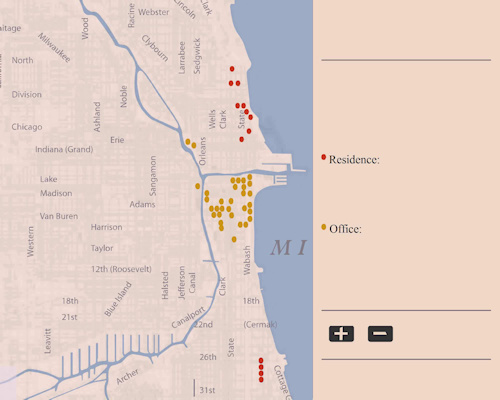| The Plan of Chicago |
| Chicago in 1909 |
| Planning Before the Plan |
| Antecedents and Inspirations |
| The City the Planners Saw |
| The Plan of Chicago |
| The Plan Comes Together |
| Creating the Plan |
| Reading the Plan |
| A Living Document |
| Promotion |
| Implementation |
| Heritage |


On November 19, 1908, the Executive Committee of the Commercial Club sent a letter to some three hundred individuals who had already donated one hundred dollars or more to pay for the preparation of the Plan of Chicago. The letter asked them to pledge an additional three hundred dollars and to help enlist other subscribers. It then named thirty-two members of the Club under whose "direct supervision" the Plan was being prepared.
This map locates the offices and homes of these thirty-two men, among whom is Daniel Burnham. The yellow dots represent their places of work, the red dots the places they lived. Drag the mouse over any of these dots to identify the individual who worked or lived in the specified location. Clicking on the dot connects the office and home of the individual. His dates of birth and death, his business or profession, and the street addresses of his workplace and residence will appear to the right of the map. Clicking on the + and - buttons will zoom the map in and out. Hold the mouse down anywhere on the map and drag it to see those areas outside the center of the city where some of the men lived.
The map and accompanying information reveal how closely together these very successful businessmen lived and worked, and how much their lives focused, as does the Plan, on the downtown. Most of them were involved in heavy industry, large-scale wholesaling, or banking and finance. Their average age in 1909, the year the Plan appeared, was fifty-two, though two of the most active leaders, Charles Norton and Clyde Carr were, respectively, thirty-eight and forty (Burnham turned sixty-three in 1909).
This map cannot represent other information regarding what might be called the shared social geography of these thirty-two men. In spite of some differences in their backgrounds, they were very much like each other and very different from the substantial portion of Chicago's population who lived and worked in other parts of the city. While only nine of the thirty-two were originally from Chicago and fourteen did not arrive in Chicago until they were at least twenty years old, thirty-one were born in the United States, and the one exception (Frederick Delano) was born in Hong Kong of American parents. Virtually all were Protestant and Republican, and all were white and male. Twenty of them (not including Burnham) had attended college at a time when higher education was not nearly as common an experience as it is now. Ten went to Harvard, Yale, or Princeton. Twenty-seven were listed in the 1906 Chicago Social Register.
They shared membership not only in the Commercial Club but also on several corporate boards and in numerous other business, social, cultural, and golf clubs. Seventeen belonged to the Union League Club, fully nineteen to the University Club. Burnham was a member of both these organizations as well as three literary and arts clubs (the Caxton Club, the Little Room, and the Cliff Dwellers) and two golf clubs (Evanston and Glenview). They also belonged to different professional organizations, such as the American Bar Association, and an impressive list of charitable, social service, and cultural boards. Eight were on the board of the Chicago Symphony, for example, and twelve on that of the Art Institute of Chicago. Such public-spirited activity was a requirement for membership in the Commercial Club, and one of many overlapping and mutually reinforcing connections among those in this extraordinarily influential, tightly knit, and like-minded group.
The Encyclopedia of Chicago © 2004 The Newberry Library. All Rights Reserved. Portions are copyrighted by other institutions and individuals. Additional information on copyright and permissions.